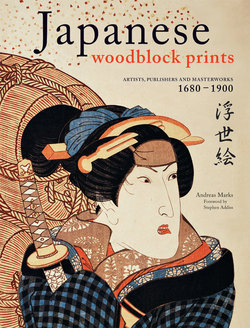Japanese Woodblock Prints

Реклама. ООО «ЛитРес», ИНН: 7719571260.
Оглавление
Andreas Marks. Japanese Woodblock Prints
Отрывок из книги
1854 Kunimitsu II. “Dawn of spring snow” (Haru no yuki yukari no akatsuki). Center panel of an ōban triptych. Publisher: Yamaguchiya Tōbei. Asian Art Museum, National Museums in Berlin.
Japanese Prints
.....
The typical subject matters of these prints were popular kabuki actors (yakusha-e) and fashionable courtesans from the pleasure quarters (bijinga), which was initially conceived by the term “floating world” (ukiyo). These subject matters were not only captured on prints, the ukiyo-e, but also in paintings called nikuhitsu (lit. “flesh brush”). From the very beginning, erotica (shunga) was a major subject that was naturally high in demand in Edo because of its dominant male population, deriving, on one hand, from the many retainers that had to be present by law to guard the provincial lords in town, and on the other hand, from the rapid development of Edo itself that attracted many male laborers from the countryside. Edo was the largest town in the world at that time with a population of one million people—nearly seventy percent of them males. Bijinga and shunga were intertwined as they both addressed—from different aspects— the idealized icon of female beauty, derived from images of courtesans that were in fact prostitutes. Everyone had access to the pleasure quarters and their services but a hierarchy of courtesans developed and the high-ranking, hence very expensive, beauties were for most people unreachable. Their appearance in superb coiffures and luxurious garments became the motifs of bijinga. The initially full-length pictures of courtesans developed in the late eighteenth century to half-length, close-up portraits that focused even more intensly on their refined manners. As beauty pictures were such a popular subject, many of these prints were on the market and the publishers and print designers had to use new means to keep their products interesting to their clientele. Playful juxtapositions, imaginary comparisons called mitate developed as a new trend. The beauties were depicted in settings derived from another context and puzzles were created that evoked the interest of consumers and became the latest thing. A development that eventually would happen with actor prints as well, but at a much later period.
C.1869 Kunichika The actors Nakamura Shikan IV as Hisayoshi, Onoe Kikugorō V as Shibata Katsushige, and Bandō Kamezō I as Shōya Kikuemon in an unidentified play, Nakamura Theater, 1869 Ōban triptych Publisher: Yorozuya Zentarō Museum of Asian Art, National Museums in Berlin
.....